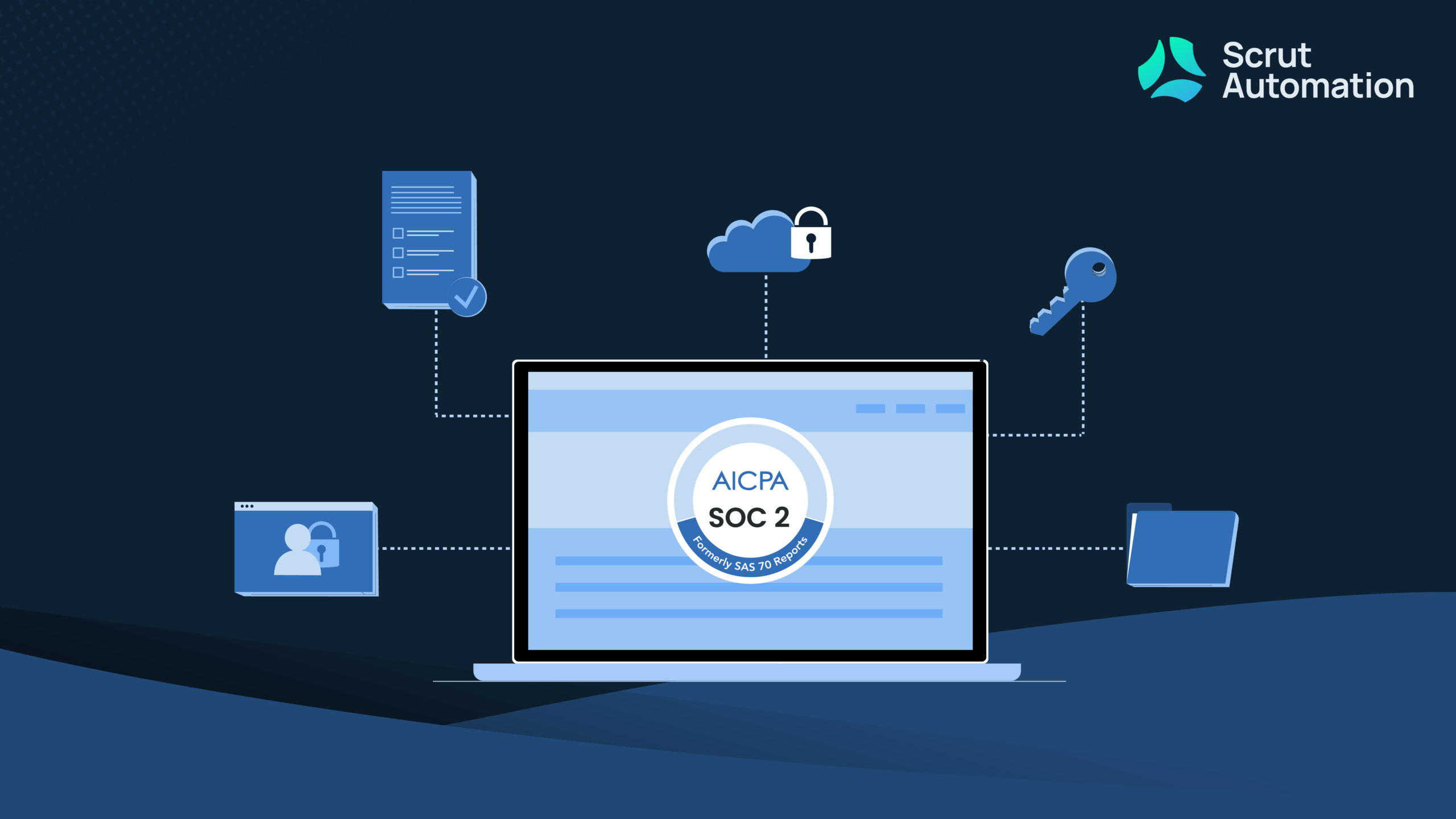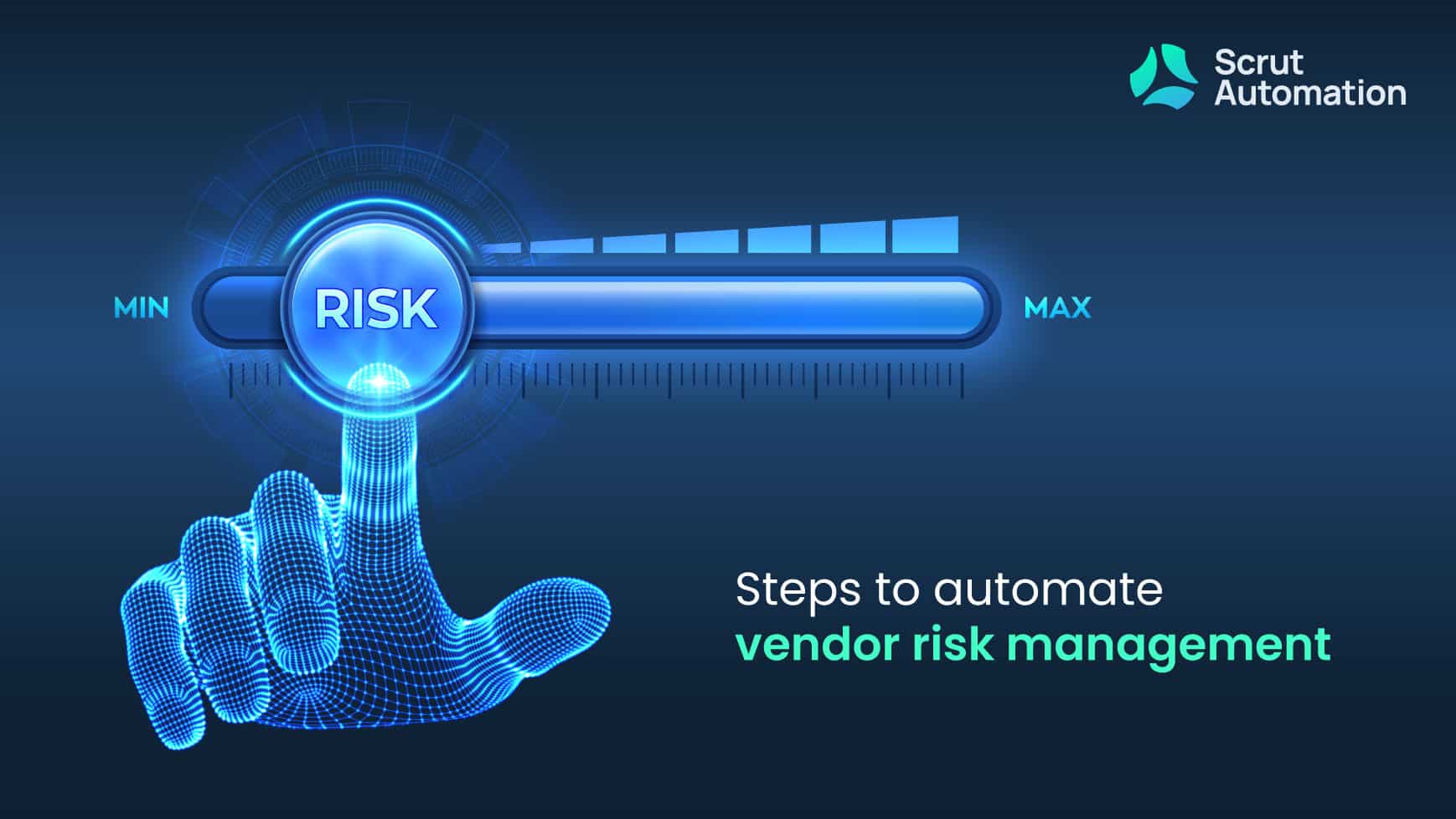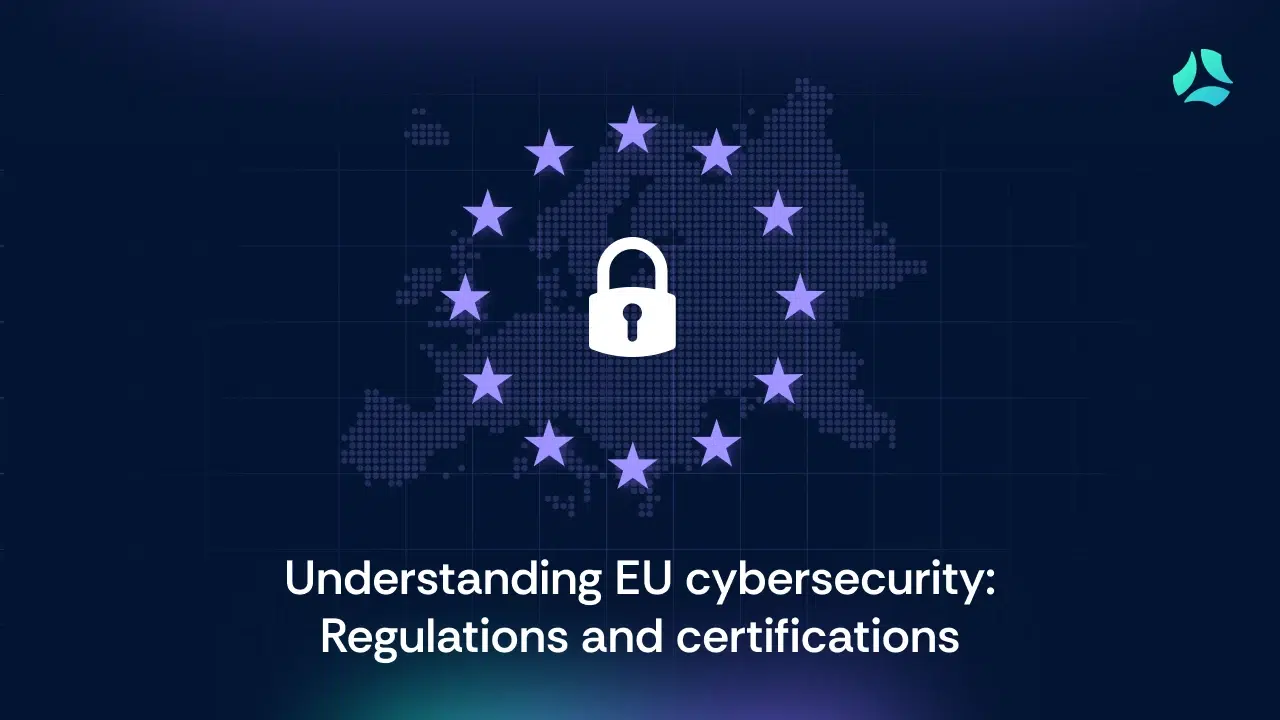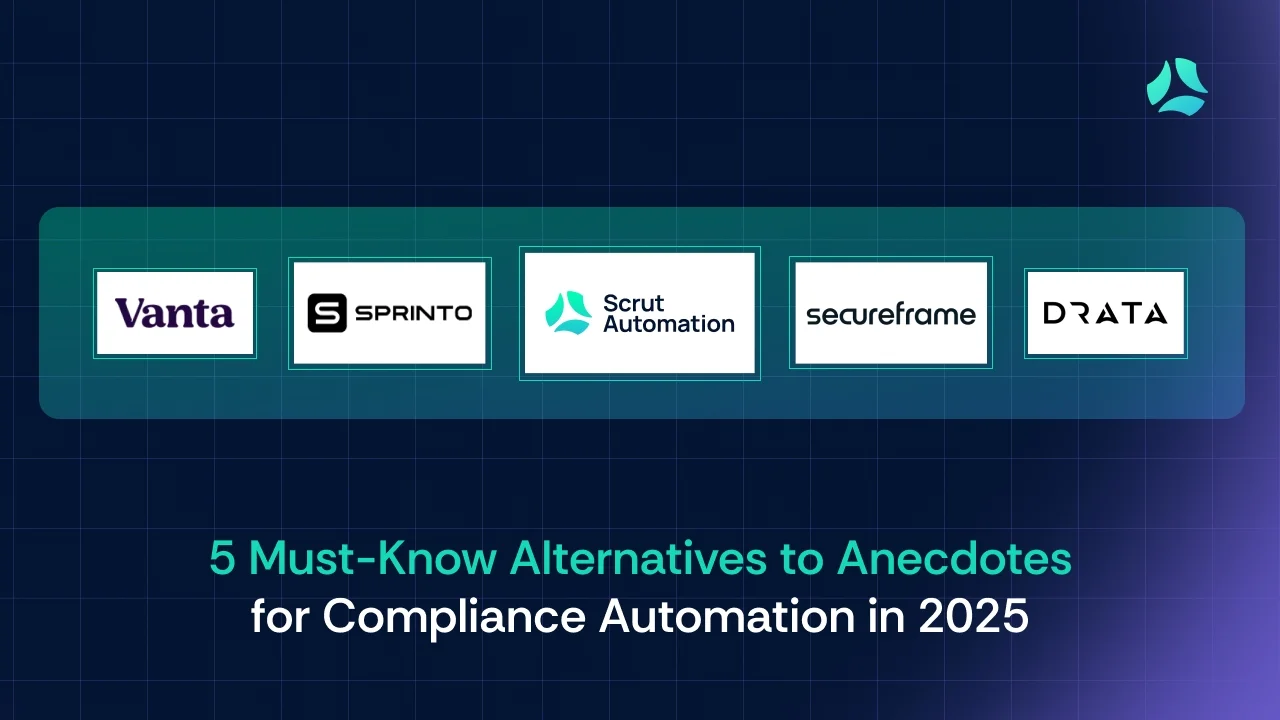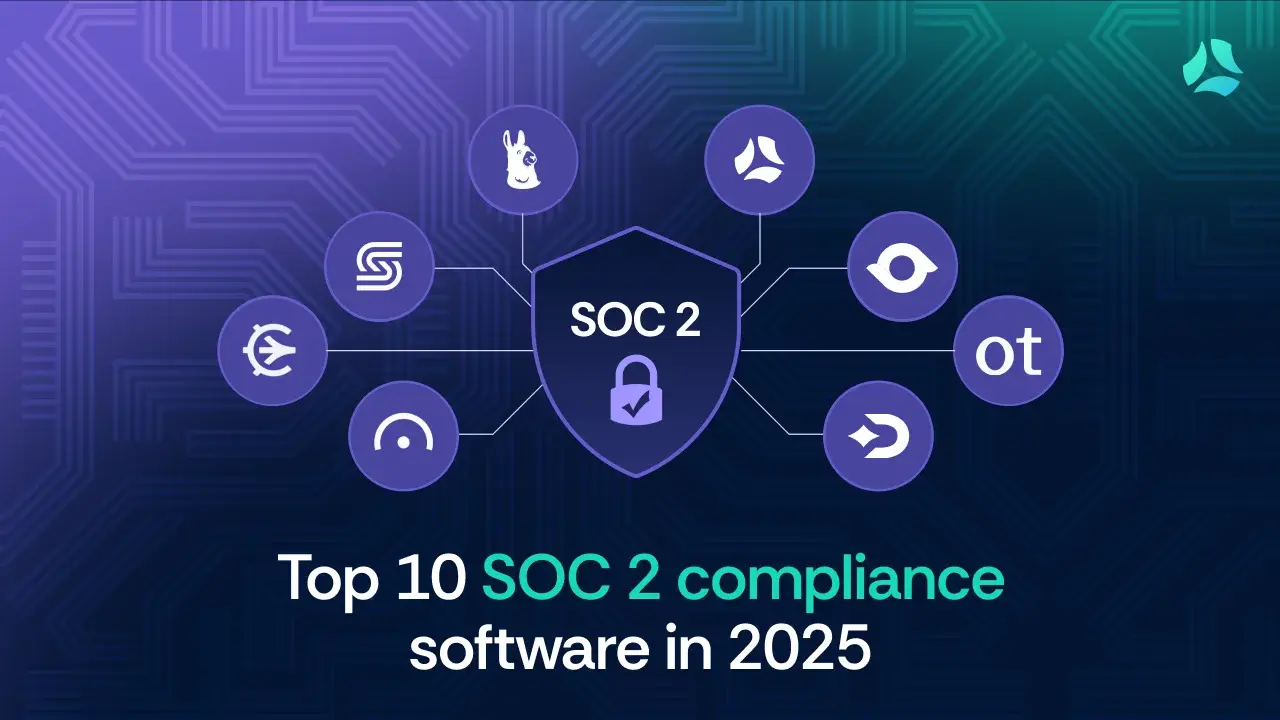In an increasingly interconnected digital landscape, the security of sensitive data and the availability of critical services have become paramount concerns for organizations across industries. With cyber threats evolving at an alarming pace and regulatory requirements becoming more stringent, adhering to comprehensive security frameworks is no longer a choice but a necessity. One such framework that addresses these concerns is System and Organization Controls 2 (SOC 2).
SOC 2 compliance has emerged as a gold standard for demonstrating an organization’s commitment to maintaining the security, availability, processing integrity, confidentiality, and privacy of customer data. It provides a comprehensive framework that assesses an organization’s controls and processes, giving both customers and stakeholders the assurance that their data is being handled securely and with the utmost care.
With data breaches making headlines on a regular basis, customers are demanding higher levels of transparency and accountability from the organizations they entrust with their sensitive information. SOC 2 compliance not only helps organizations meet these demands but also instills a sense of trust that can be a significant competitive advantage in today’s data-driven economy.
As organizations strive to achieve and maintain SOC 2 compliance, the sheer complexity of managing controls, evidence, and reporting requirements can be overwhelming. This is where automation steps in as a game-changer. Automation technology offers the capability to streamline and enhance various aspects of the compliance process, from continuous monitoring to evidence collection and reporting. By automating routine tasks, organizations can free up valuable human resources to focus on more strategic security initiatives.
In this blog, we will delve into the realm of SOC 2 automation software and its pivotal role in simplifying and strengthening the compliance journey. We will explore the various facets of SOC 2 compliance, the challenges associated with manual processes, and the transformative impact of automation.
What are the challenges of manual compliance processes?
Historically, organizations have approached SOC 2 compliance through manual efforts involving spreadsheets, document repositories, and painstakingly tracked email chains. This approach often involves manual data collection, assessment, and reporting, leading to inefficiencies, potential errors, and limited visibility into the compliance landscape.
The shortcomings of manual processes in the context of SOC 2 compliance are numerous and significant. These limitations include:
- Human Error: Manual data entry and calculations introduce the risk of errors, potentially leading to inaccurate compliance assessments and reporting.
- Time-Consuming: Manually collecting evidence, updating documentation, and generating reports can be extremely time-consuming, diverting valuable resources from other critical tasks.
- Lack of Scalability: As organizations grow and expand, the demands of compliance increase exponentially. Manual processes struggle to scale effectively, leading to bottlenecks and inconsistencies.
- Limited Visibility: Manual systems often lack real-time visibility into compliance status, making it challenging to proactively identify and address issues.
- Compliance Fatigue: The repetitive nature of manual compliance tasks can lead to burnout among compliance teams, reducing overall effectiveness.
What is SOC 2 automation software? What is its purpose?
SOC 2 automation software refers to a category of software designed to automate and streamline various aspects of SOC 2 compliance. This software encompasses a wide range of functionalities, from continuous monitoring and evidence collection to policy management and reporting.
The primary purpose of SOC 2 automation software is to replace or augment manual processes with technology-driven solutions, ultimately leading to improved efficiency, accuracy, and effectiveness in achieving SOC 2 compliance.
What are the features of the SOC 2 automation software?
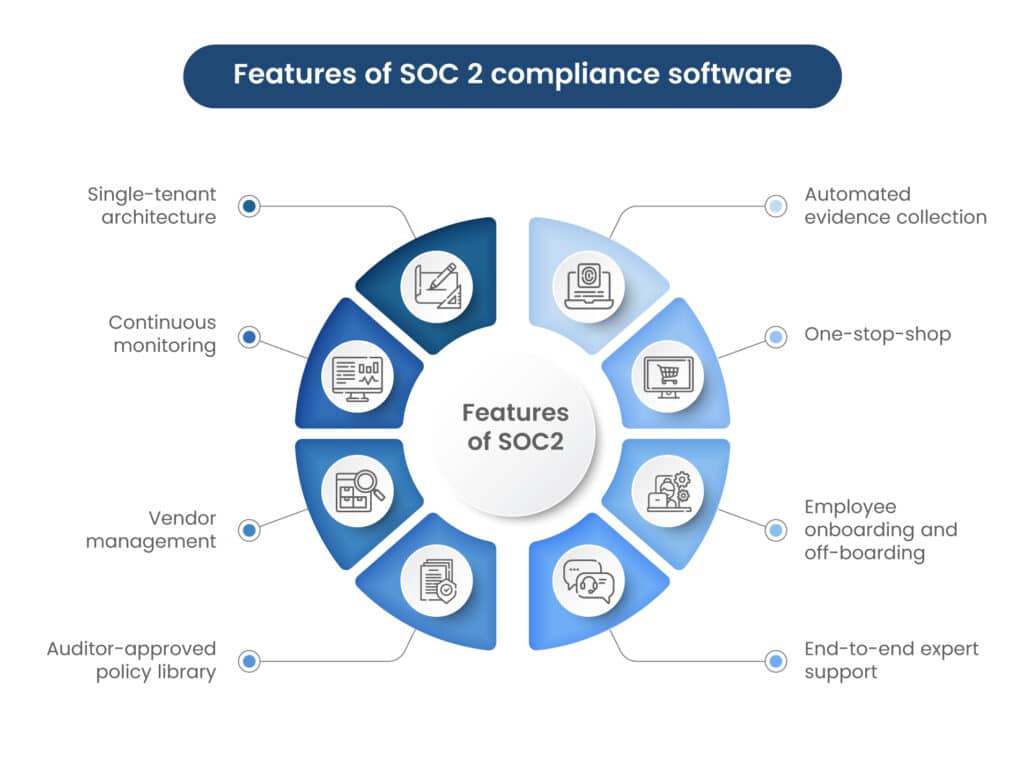
The features of the SOC 2 automation software are given below:
1. Single-tenant architecture
A single-tenant database architecture uses a software application and database for each client, which means the clients cannot share the databases and applications between them since they have their instances of database and applications. Single-tenant architecture has a specific design, making it unique since it allows only one instance per SaaS server. Thus, it mitigates risk, ensures confidentiality, and allows more customization options.
2. Automated evidence collection
One of the core features of SOC 2 automation software is eliminating complicated spreadsheets, folders full of screenshots, and other tedious and manual tasks. The best-fit software automates 85% of SOC 2 compliance as soon as you sign up.
3. Continuous monitoring
The best SOC 2 compliance software will continuously monitor your controls and alert you if your information security is at risk. For example, SOC 2 automation should alert you if an employee skips the onboarding or offboarding process or a new customer database created isn’t encrypted yet or the password policy is not as per security benchmarks. Good software will provide detailed guidance to correct gaps and issues.
4. One-stop-shop
The compliance automation software you choose should be able to scale as your organization grows. Look for software that can help you comply with multiple frameworks and regulations like SOC 2, GDPR, CCPA, HIPAA, PCI-DSS, and ISO 27001.
5. Vendor management
Checking vendor management risks is as important as checking the security of your internal control. The SOC 2 software you choose should help you manage all your vendor-related documents like vendor agreements and security certifications in one spot.
6. Employee onboarding and off-boarding
The ability to track and smoothly onboard and off-board employees is a crucial component of SOC 2 compliance. Select software that enables you to automate the processes, keep track of security training, let employees read and approve policies, and avert problems before they happen.
7. Auditor-approved policy library
Creating a library of internal security policies and keeping up with the latest security policies can be time-consuming. Choose SOC 2 software with a library of auditor-approved policy templates.
8. End-to-end expert support
Most automation software offers chat and call tech support, but only some software offers compliance expert support. Our team of SOC 2 experts will help you prepare for an audit and be with you throughout the audit process.
What are the benefits of the SOC 2 compliance automation software?
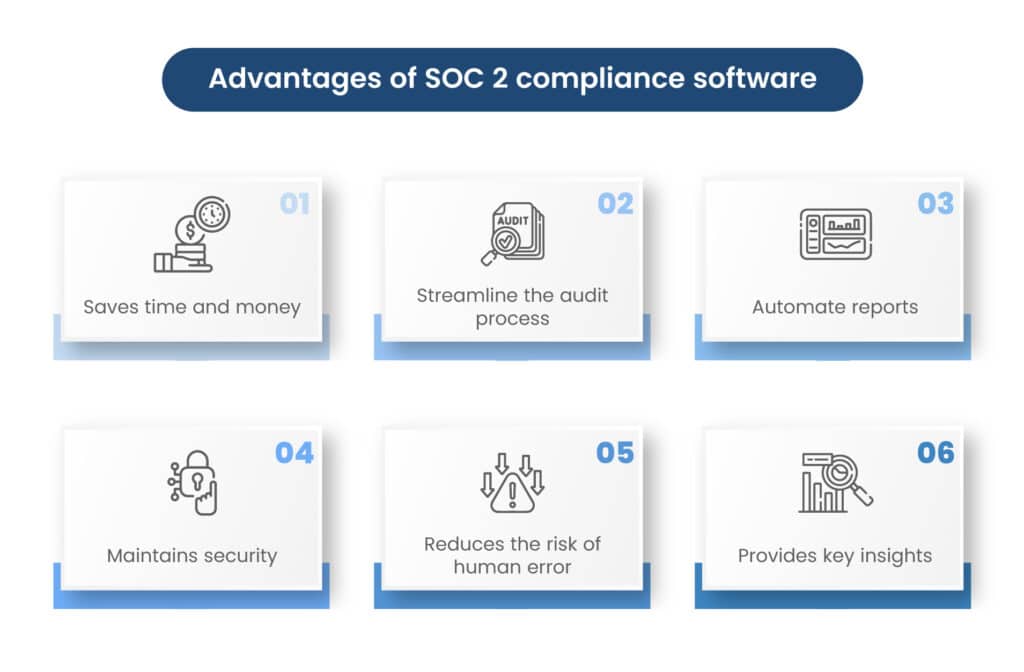
From time and cost-saving to improved and streamlined relationships with your auditors, SOC 2 automation software provides many benefits, and here are a few:
1. Saves time and money
Manually processing SOC 2 compliance is tedious and time-consuming. Collecting various spreadsheets and database tables, organizing screenshots and other evidence, and manually tracking incidents, assets, and vendors is time-consuming. All of this means the valuable resources of the company – employees – have less time for doing other high-priority, revenue-generating tasks. One of the major benefits of SOC 2 automation software is that it can automate all those tedious and time-consuming jobs.
The SOC 2 automation software handles evidence collection, employee onboarding and offboarding, tracking vendors and assets, risk assessment, control mapping, and a dashboard to check status. If your team is spending months in getting SOC 2 compliance, you are losing money and productivity. With SOC 2 automation software, you can eliminate costs that go into partners, consultants, or new tools.
2. Streamline the audit process
Instead of relying on spot checks, assuming continuous compliance, and collecting evidence from multiple sources, use automation software to streamline this process. As a result, there will be less back and forth between an auditor and the business, and both parties will benefit from a quicker and more affordable process.
3. Automate reports
Using a manual process to answer prospective customers’ questions takes a lot of time. With good SOC 2 automation software, real-life reports are generated to answer infosec posture questions, and the auditors can download available control evidence only with a few clicks. Scrut’s SOC 2 automation software shares continuous, real-time control monitoring, reports, certifications, policies, and more on your personalized dashboard.
4. Maintains security
SOC 2 isn’t just about demonstrating security; it’s about being secure. Having the right controls for customer data, confidential information, and system availability will make your business run smoothly and save you from potential legal issues and customer churn. A good SOC 2 automation software ensures your security program is running smoothly-not only for audits but maintaining a solid security posture.
5. Reduces the risk of human error
25% of unplanned downtime is caused by human error. A good SOC 2 automation software mitigates human risk by offloading repetitive tasks and similarly automates them every time and alerts you to change human behavior to mitigate risks.
6. Provides key insights
SOC 2 automation software helps you get insights into how your security posture is operating at any given point and insights on improvement.
How to select the right SOC 2 compliance automation software for your organization?
The journey toward SOC 2 compliance automation is a critical decision that requires careful consideration. The selection of the right SOC 2 compliance software can significantly impact the effectiveness and success of your compliance efforts. In this section, we will delve into the key factors to consider when choosing the most suitable software solution for your organization.
1. Customizability for your organization
Every organization has unique processes, workflows, and compliance requirements. When evaluating SOC 2 automation software, prioritize solutions that offer a high degree of customizability. The software should allow you to tailor the compliance framework, controls, and reporting to align with your specific business operations and industry needs.
2. Integration capabilities with existing tools
Seamless integration with your existing technology ecosystem is crucial. Your organization likely uses various tools for security, IT management, and communication. Look for SOC 2 software that can integrate with these tools, enabling data exchange and reducing redundancy. This integration enhances efficiency and provides a holistic view of your compliance landscape.
3. Scalability for future growth
Your organization’s compliance requirements will evolve as your business expands. Therefore, choose a SOC 2 compliance software that can scale alongside your growth. The software should accommodate additional controls, users, and data volumes without compromising performance. This scalability ensures that your compliance efforts remain robust and effective over time.
4. Vendor reputation and support
The reputation and support of the software vendor are critical considerations. Research the vendor’s track record in the compliance and security space. Look for customer reviews, references, and case studies to assess their credibility. Additionally, evaluate the level of customer support, training resources, and ongoing assistance the vendor provides to ensure a smooth implementation and efficient usage.
5. Security and data privacy
Given the nature of SOC 2 compliance, security and data privacy should be paramount. Ensure that the automation software adheres to rigorous security standards, including encryption, access controls, and data protection measures. An audited security certification, such as SOC 2 Type II, can offer additional assurance of the software’s security practices.
6. Reporting and analytics capabilities
Effective reporting and analytics capabilities are essential for monitoring and demonstrating compliance. The automation software should offer robust reporting features, including customizable compliance reports, audit trails, and real-time analytics. These capabilities empower your organization to gain insights into compliance status and performance metrics.
7. User-friendly interface
The usability of the automation software directly affects its adoption and effectiveness. Prioritize solutions with an intuitive and user-friendly interface. A well-designed interface streamlines navigation, reduces training time, and ensures that your compliance team can efficiently leverage the software’s capabilities.
For a complete buyer’s guide to SOC 2 compliance software, refer to our blog here.

How to implement SOC 2 compliance automation in your organization?
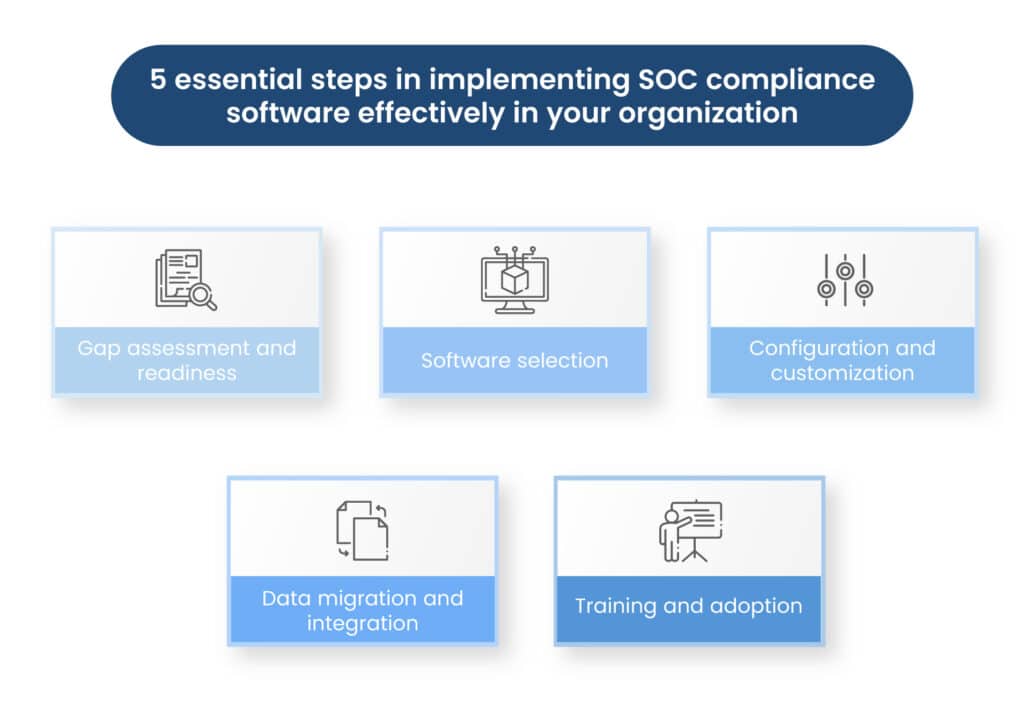
The successful implementation of SOC 2 compliance software is a pivotal step toward revolutionizing your organization’s compliance efforts. In this section, we will guide you through the essential steps of implementing the software, from assessing readiness to overcoming potential challenges.
1. Gap assessment and readiness
Begin by conducting a thorough gap assessment to understand your organization’s current compliance posture. Identify areas where automation can enhance efficiency and effectiveness. Assess the readiness of your internal teams for the changes that automation will bring.
2. Software selection
Based on your assessment, choose the SOC 2 compliance software that aligns best with your organization’s needs. Consider the factors outlined in the previous sections, such as customizability, integration capabilities, scalability, and vendor support.
3. Configuration and customization
Once selected, configure and customize the software to reflect your compliance requirements and processes. Tailor the workflows, controls, and reporting to match your organization’s unique operations.
4. Data migration and integration
Migrate existing compliance data to the automation software and integrate it with your existing tools and systems. This step ensures a seamless transition and consistent data flow between platforms.
5. Training and adoption
Provide comprehensive training to your compliance team and relevant stakeholders on how to effectively use the new automation software. Encourage adoption and address any concerns to ensure a smooth transition.
How can an organization ensure compliance with SOC 2 compliance software?
Implementing SOC 2 automation software is just the beginning of your compliance journey. In this section, we will explore how to ensure ongoing compliance using automation software, adapt to changing requirements, and leverage automation for audits and assessments.
1. Ongoing monitoring and maintenance
- Continuous monitoring: One of the primary advantages of automation software is its ability to provide continuous monitoring of your compliance controls and processes. Regularly review automated reports and alerts to promptly address any anomalies or deviations from the expected compliance standards.
- Data accuracy and updates: Regularly update and validate the data within the SOC 2 software. Outdated or inaccurate data can lead to incorrect compliance assessments. Schedule routine data audits to maintain data integrity.
2. Adjustments to changing compliance requirements
- Stay informed: Keep up-to-date with changes in SOC 2 compliance requirements, industry standards, and regulatory frameworks. Automation software should allow you to easily adapt your controls and workflows to address evolving compliance demands.
- Flexibility and customization: Leverage the customization capabilities of your SOC 2 software to adjust controls, policies, and processes as compliance requirements evolve. Regularly review and modify your configurations to ensure alignment with the latest standards.
3. Leveraging automation for audits and assessments
- Streamline audits: During audits and assessments, SOC 2 software can be a game-changer. Generate comprehensive audit reports and evidence documentation with ease. Automation ensures accuracy and significantly reduces the time and effort required for audits.
- Demonstrate continuous compliance: The automation software’s continuous monitoring capabilities enable you to demonstrate ongoing compliance rather than just point-in-time compliance during audits. This can bolster your organization’s reputation and build trust with stakeholders.
- Auditing the software: Perform periodic audits of the SOC 2 compliance software to ensure that it is functioning as intended. This includes validating data integrity, audit trails, and security measures within the software.
How Scrut Streamlines SOC 2 Compliance: From Audit to Reporting
The advantage of using automation tools for SOC 2 compliance like Scrut is that they provide a unified view of everything compliance-related. This includes a dashboard that provides an overview of cloud risk assessments, control reviews, employee policy attestations, and identification of compliance gaps, allowing the compliance team to focus on areas that need to be fixed.
1. Compliance in a single unified view with Scrut
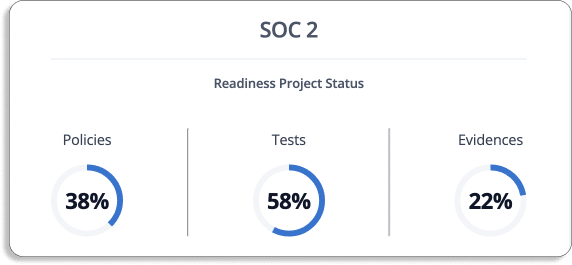
Scrut Automation provides an easy-to-use dashboard with quick insights into your compliance and information security posture. From a single dashboard with detailed monitoring and feedback, you can check your compliance status, upload policy evidence, send security surveys, and identify deviations.
Scrut’s policy library is a feature that can be utilized to set up a SOC 2-compliant information security program quickly. The library includes over 50 pre-built policies that can be used as it is or customized to meet an organization’s specific needs.
The built-in editor allows the compliance team to edit and review the policies by Scrut’s SOC 2 compliance experts to ensure they meet the standards.

In addition to the pre-built policies, Scrut allows organizations to upload their policies, providing flexibility and the ability to align with the organization’s existing policies.
Scrut’s onboarding assistance from its SOC 2 compliance experts can provide guidance and support for implementing the policies, ensuring that they are properly implemented and in compliance with SOC 2 standards.
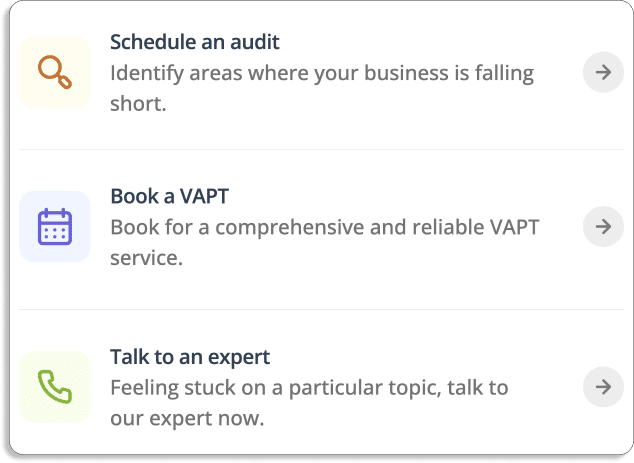
The experts ensure that the organization’s SOC 2 compliance program is set up correctly and provide best practices for maintaining compliance over time.
2. Actively monitor and stay on top of your compliance posture:
Users can identify gaps and critical issues in real-time with continuous automated control monitoring, reducing costs and resources wasted doing manual work. The platform maintain daily compliance by staying on top of your compliance posture with automated, configurable alerts and notifications.
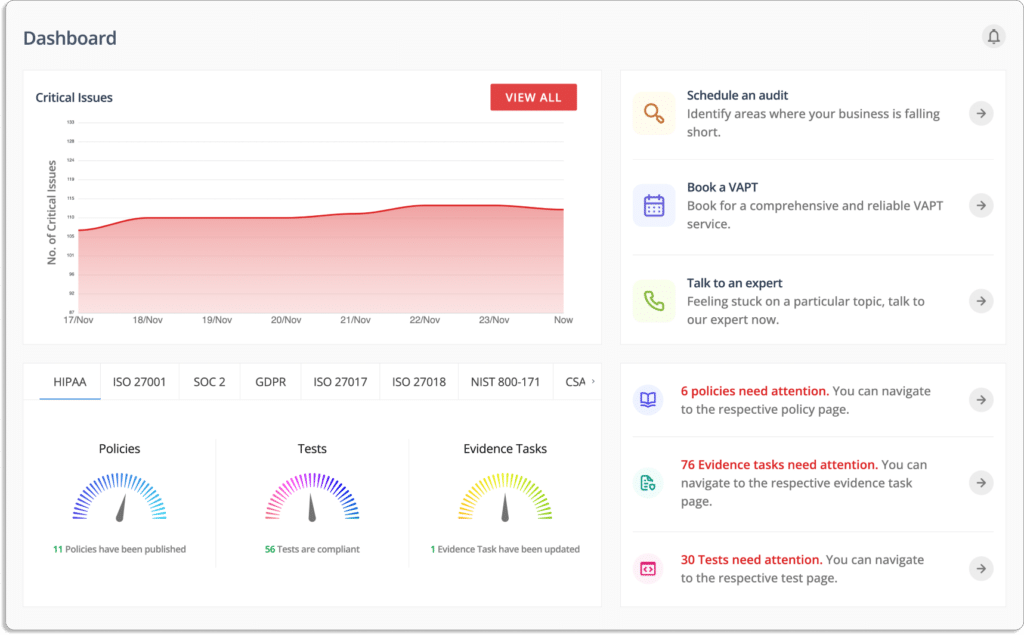
As shown in the above screenshot, the Scrut platform offers a real-time and unified view of risks and compliance and contextual insight to ensure your organization’s security.
Using the tool, you can review the summary of each SOC 2 policy, including the compliance status, clauses, and controls that can be assigned to an individual for responsibility.
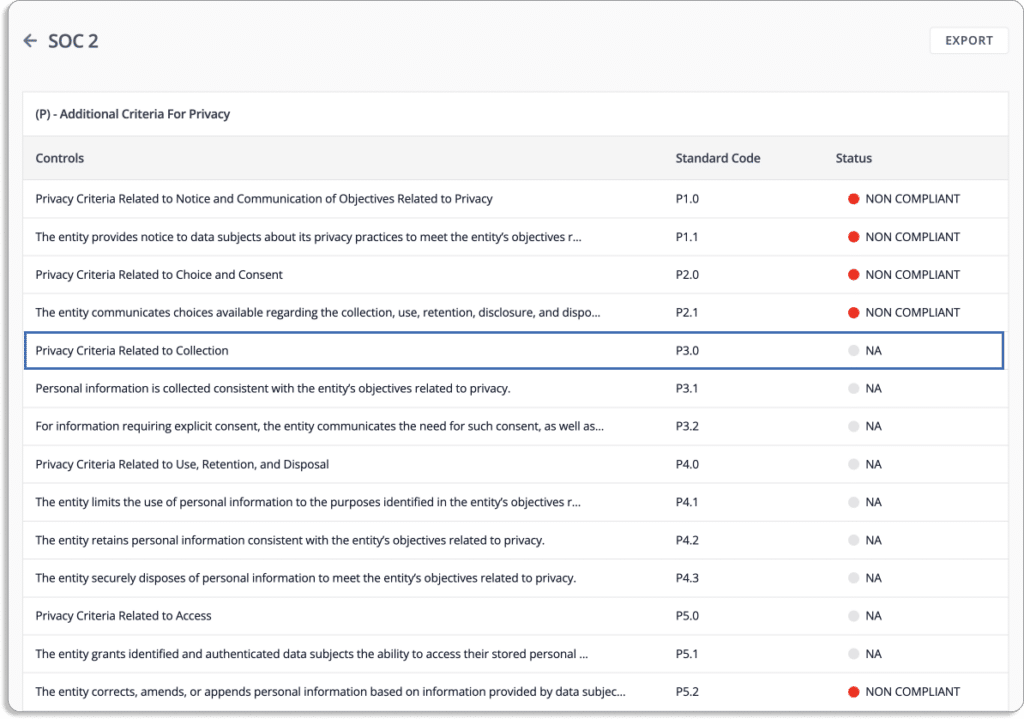
3. Automated Evidence Collection Simplifies Audits:
Professional compliance experts work tirelessly to gather all the evidence their auditor requires just before a scheduled audit. One of the primary reasons security professionals choose automation tools is that the operations platform allows them to easily collect, manage, review, and re-use evidence for audits.
With 70+ integrations across commonly used applications, evidence collection is no longer a tedious, repetitive manual process. Scrut automates over 65% of the evidence-collection process across your application and infrastructure landscapes against pre-mapped SOC 2 controls. You can assign evidence-collection tasks to team members or “owners” and track their progress through the platform.
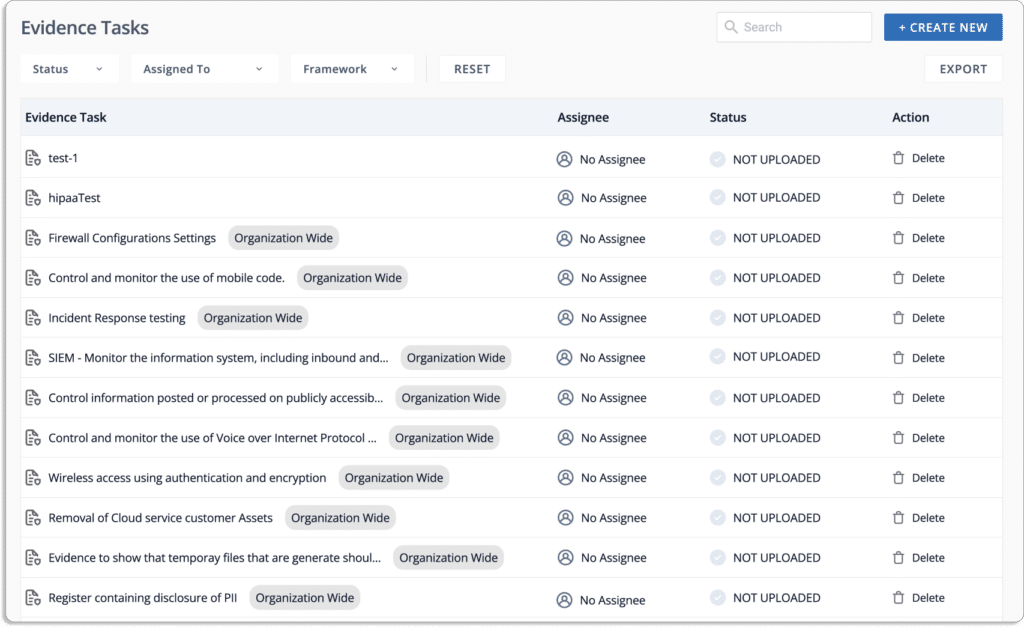
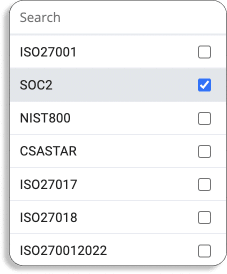
An automated SOC 2 compliance tool like Scrut allows you to share evidence artifacts with auditors and collaborate through the platform without needing separate communication channels. You can collaborate with the auditor via the automation tool for painless audits.
An automated control system is essential with the amount of data available today. It’s too big a task to entrust to your overworked compliance staff, and it’s far too expensive to keep up in the long run. Using the Scrut platform, you can streamline all of your compliance activities. Different records may necessitate different levels of approval.
4. Manage evidence of compliance with ease:
How can automation help you become the trusted company that consumers seek?
The automation platform provides modules for easily managing audit-worthy proof and evidence. Customers have real-time visibility into your compliance posture with no manual effort.
Create and share an auto-populated company-branded security page with Scrut’s Trust Vault to highlight your information security posture. You can store and manage all evidence documentation required to demonstrate compliance, as shown in the screenshot below.
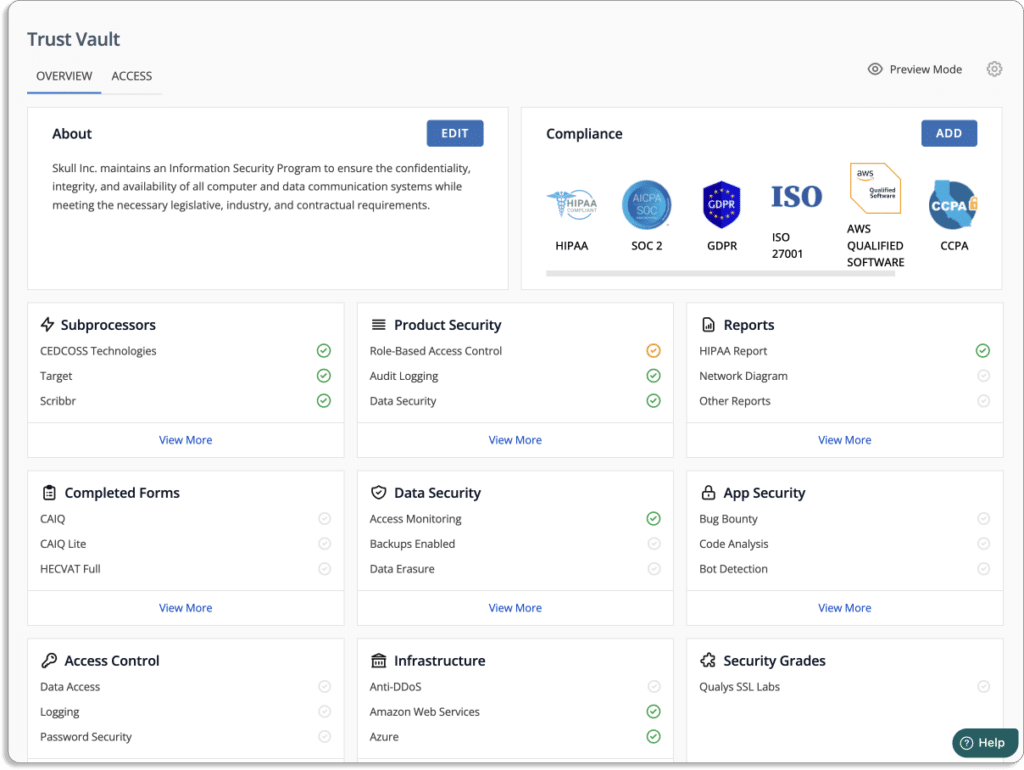
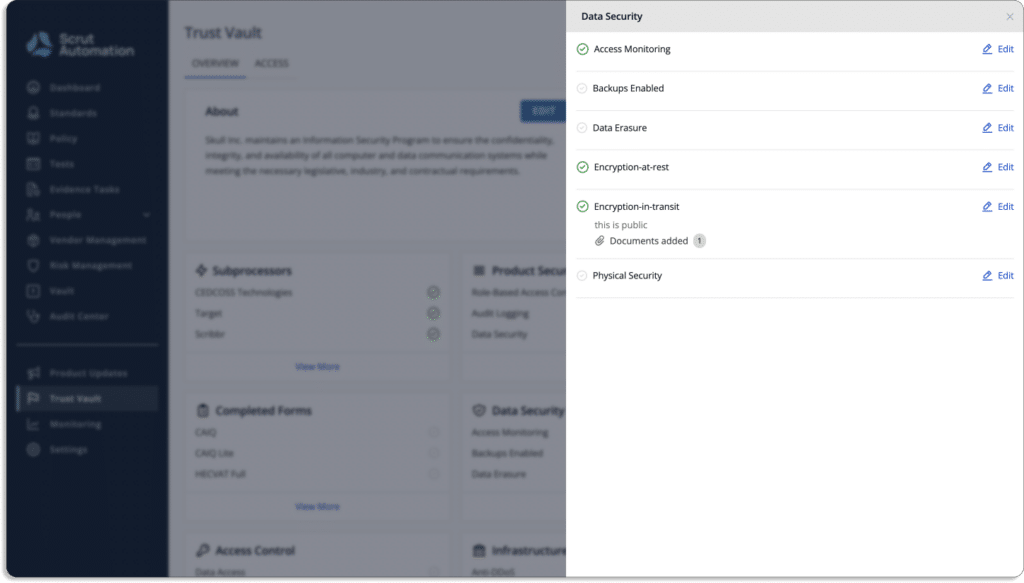
5. Access to SOC 2 compliance experts:
By allocating a dedicated compliance expert, auditor, and consultant who guide you through the entire process, SOC 2 automation software like Scrut reduces the burden on your team.
Case study: Learn how Scrut helped BarRaiser streamline its robust information security posture.
See some of our customer’s reviews below:




Winding up
In today’s interconnected digital landscape, SOC 2 compliance stands as a vital shield against cyber threats and a beacon of trust for customers. Manual compliance processes have shown their limitations, from errors to inefficiencies. Enter SOC 2 compliance software, offering efficiency, accuracy, and adaptability. It saves time and money, streamlines audits, and maintains security. Selecting the right software involves considering factors like customizability, integration, and scalability.
Yet, implementation is just the start. Ongoing compliance demands continuous monitoring, adapting to changing requirements, and leveraging automation for audits. This software isn’t just a tool; it’s a transformative force for organizations navigating the complexities of data security and regulatory adherence. Embracing SOC 2 compliance software is a strategic step toward a safer and more trustworthy digital landscape.
FAQs
SOC 2 compliance is a framework that addresses security, availability, processing integrity, confidentiality, and privacy concerns for organizations handling sensitive data. It’s crucial due to evolving cyber threats and stricter regulations, to ensure customer data is secure and handled with care.
The following are the advantages of SOC 2 compliance software:
– Time and cost savings
– Streamlined audit process
– Automated reports
– Improved security
– Reduced risk of human error
– Key insights into the security posture
SOC 2 compliance software represents a transformative force in data security and regulatory adherence. It saves time, enhances security, streamlines audits, and fosters trust in the digital landscape.

Megha Thakkar has been weaving words and wrangling technical jargon since 2018. With a knack for simplifying cybersecurity, compliance, AI management systems, and regulatory frameworks, she makes the complex sound refreshingly clear. When she’s not crafting content, Megha is busy baking, embroidering, reading, or coaxing her plants to stay alive—because, much like her writing, her garden thrives on patience. Family always comes first in her world, keeping her grounded and inspired.
